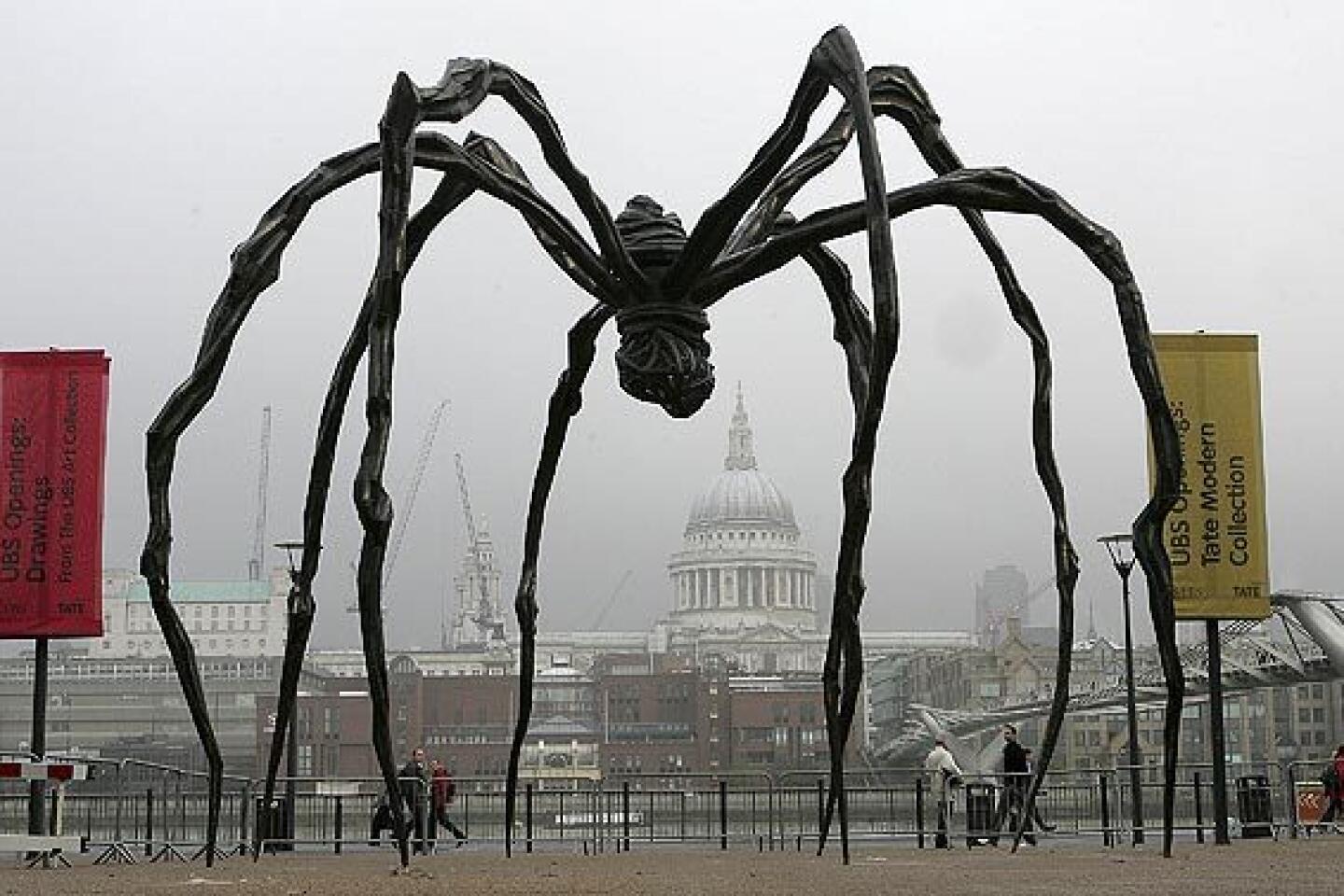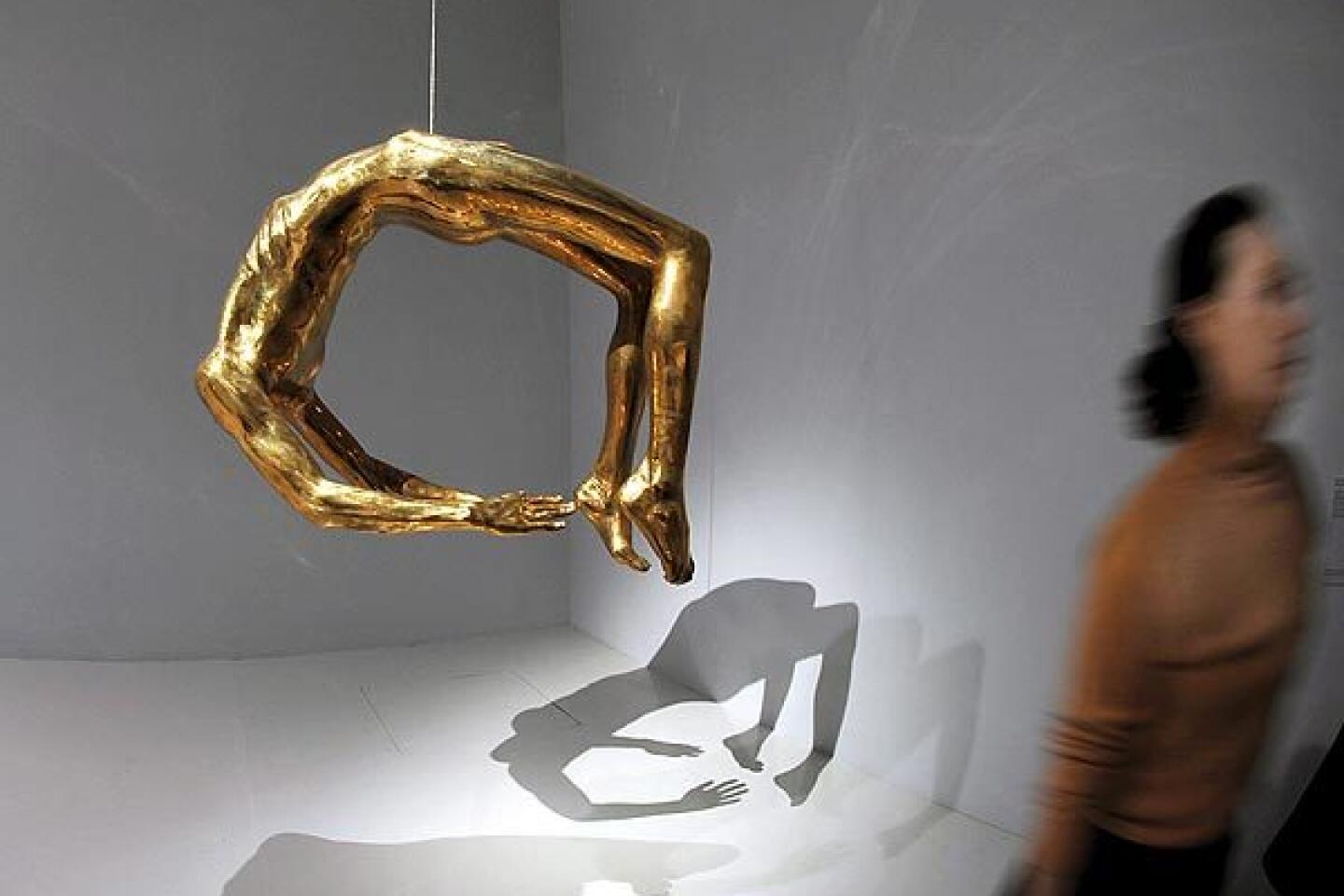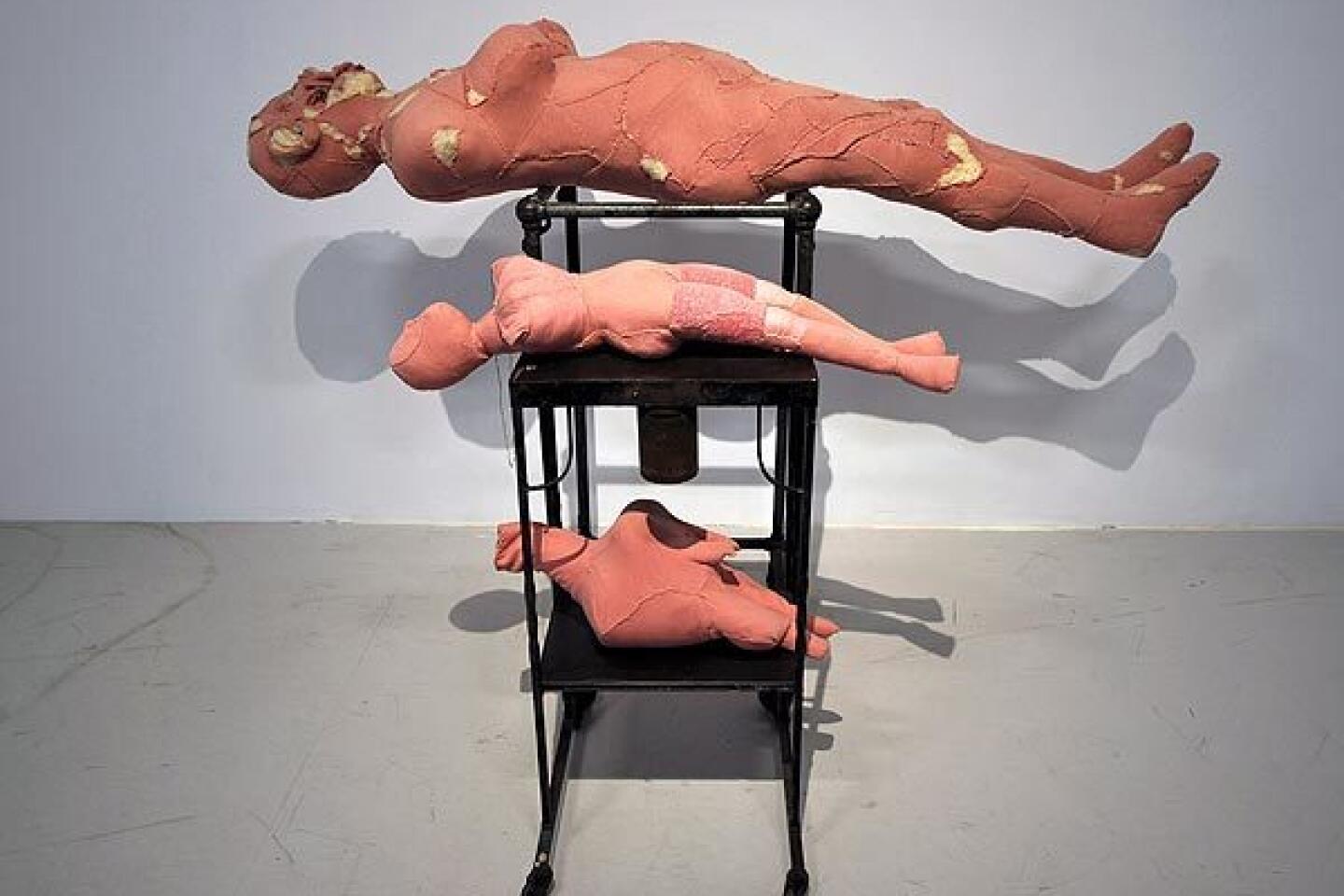Louise Bourgeois dies at 98; revered artist’s work was a ‘form of psychoanalysis’
- Share via
Louise Bourgeois, an internationally revered artist whose intensely personal work was inspired by psychological conflict, feminist consciousness and a fertile imagination, has died. She was 98.
Bourgeois died Monday at Beth Israel Medical Center in Manhattan after suffering a heart attack on Saturday, said Wendy Williams, managing director of the Louise Bourgeois Studio in New York.
Known for sculptures of giant spiders, women with extra breasts, double-headed phalluses and rooms that resonate with loneliness and dread, Bourgeois was a fearless creative force whose work could be disturbing and perversely witty. Although she got little attention from the art world until her seventh decade, she became its grande dame, constantly in demand and showered with honors.
Bourgeois often left viewers with questions about the meaning of her work, but made no secret of painful experiences that shaped it. The spiders — including “Maman,” a 35-foot-tall piece commissioned for the inauguration of the Tate Modern gallery in London in 2000 — are a tribute to her beloved mother, whom she described as a pillar of inner strength who was “clever, patient and neat as a spider.”
Her father, whom the artist perceived an a domineering philanderer, didn’t fare so well. In “The Destruction of the Father” — a 1974 installation that appeared at the Los Angeles Museum of Contemporary Art in 2008-2009, in a traveling retrospective — Bourgeois re-created a youthful fantasy of her father being dismembered and devoured by his family.
“She smashed a taboo,” said Christopher Knight, The Times’ art critic. “Bourgeois was the first modern artist to expose the emotional depth and power of domestic subject matter. Before her, male artists had only nibbled around the edges, and women just weren’t allowed.”
Born in Paris on Christmas Day 1911, Bourgeois lived in France until 1938. The second of three children born to Josephine Fauriaux and Louis Bourgeois, she was part of a family that operated a tapestry gallery below their apartment on Boulevard Saint-Germain and a tapestry restoration firm in a village south of Paris. They had a comfortable life, except for a period during World War I, but her parents’ marriage was fraught with tension that escalated when Louis had a liaison with an Englishwoman who was the children’s live-in tutor.
Louise’s resentment about the ménage à trois eventually became fodder for her art. In a 1982 New York Times interview, she said that twisted forms in her work reflected her childhood dream of getting rid of her father’s mistress by “twisting her neck.” But Bourgeois’ indomitable spirit and creative energy prevailed.
“My work is a form of psychoanalysis,” she wrote in an e-mail exchange with the Los Angeles Times in 2007. “It is a way of coming to grips with my anxiety and fears. It is an attempt to be a better person.… There is a lot of ambivalence in the work. There are many hanging pieces, which signify a fragile state. There are pieces that oscillate and rock, which also convey fragility. We all have pink days and blue days. I am trying to seek a balance between the extremes that I feel. I want to be reasonable.”
In the art world’s eyes, she succeeded.
Art historian Robert Storr has praised Bourgeois as “among the most inquisitive and best-informed artists of her generation. No analysis of her work or its internal dynamics that sidesteps this fact, or fails to consider the unique mix of intuition and erudition, psychological compulsion and sheer intelligence that has guided her, can possibly claim to measure the full range of its meanings.”
Bourgeois studied art at several Parisian schools, including the Académie des Beaux-Arts and the Académie Julian, and in the studio of painter Fernand Legér. In 1938, she married American art historian Robert Goldwater and moved to New York, where she spent the rest of her life.
She began to establish herself as an artist in the 1940s while raising three sons, Michel, Jean-Louis and Alain, and had her first solo exhibition in 1945 at a New York gallery. Her husband, a professor at New York University, became known for exploring connections between so-called primitivism and Western modernism. The couple enjoyed a rich intellectual life until Goldwater’s death in 1973, about a decade before Bourgeois gained wide recognition.
She began her career as a painter of tapestry-like abstractions, but soon became intrigued with the Surrealists’ exploration of the subconscious as a source of images and ideas. Her “Femme-Maison” paintings of 1946 and1947 merge Surrealism with feminism in depictions of women with houses for heads, defined by their domestic roles.
As her interest shifted to three-dimensional forms, she turned to sculpture and worked with many materials, including wood, metal, latex, plaster, marble and bronze. Her early totem-like figures led to sexually explicit sculptures and ambitious installations that evoke troubling states of mind and physical conditions.
Bourgeois participated in feminist activities in the 1960s and wore the badge of feminism proudly while forging her own style and sensibility. “I believe women should have equal opportunity and rights,” she wrote in her e-mail exchange with The Times. “My work does make fun of the macho man, whether it was my father or Freud.” But she rejected the notion of a feminist aesthetic. “My work deals with problems that are pre-gender,” she wrote. “For example, jealousy is not male or female.”
A 1982 retrospective exhibition at the Museum of Modern Art in New York launched Bourgeois into a sphere of fame and influence well beyond Manhattan’s contemporary art circles. In the ensuing years, her work entered collections in major museums worldwide and she won dozens of awards, including the French Ministry of Culture’s Grand Prix National de Sculpture in 1992 and the United States’ National Medal of Arts in 1997. She represented the U.S. at the 1993 Venice Biennale and was the first living artist to have an exhibition at the Hermitage Museum in St. Petersburg, Russia, in 2002.
Her belated discovery by the art world was “a blessing in disguise,” she wrote to The Times. “It allowed me to work undisturbed, at my own pace and in my own way.… I believe that when people see the work that I have produced over a long period of time they will see the consistency of what I want to say.”
But when asked how she wanted to remembered in art history books, she responded: “I’m not that interested in art history. I was married to an art historian and had enough of it. Art history is one thing and being an artist is another. I know I’m part of history, just a tiny stone in a very big wall.”
She is survived by sons Alain and Jean-Louis, two grandchildren and one great-grandchild. Her son Michel died in 1990.
Services will be private, Williams said.
Muchnic is a former Times staff writer.
More to Read
Start your day right
Sign up for Essential California for the L.A. Times biggest news, features and recommendations in your inbox six days a week.
You may occasionally receive promotional content from the Los Angeles Times.










